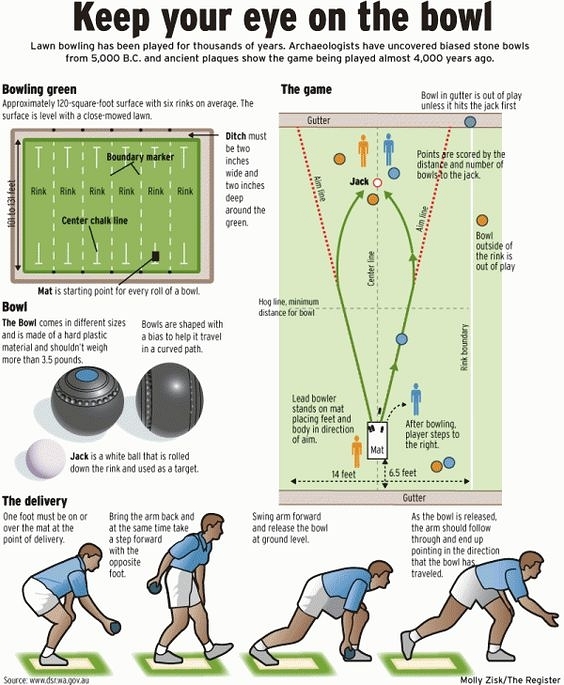What is Lawn Bowling?
Lawn Bowling is a precision sport where the goal is to roll slightly radially asymmetrical ‘bowls’ closer to a smaller white ball (the “jack”) than one’s opponent is able to do. It is a truly global sport, played from everywhere from New Zealand, to the Philippines, Brazil to Pakistan. In countries like Australia and Malaysia, it is a nationally televised sport, and it has internationally famous players. It is a sport where someone in their 20s can compete at the national level with someone in their 80s. It requires skill and stamina. It is fun and addictive once you’ve caught the bug!
Is Lawn Bowling the same as Bocce?
Bocce and Lawn Bowling are cousins but have some distinct differences. The Bocce Ball is round whereas the Lawn Bowl is round in only one direction and elliptical in the other, giving it a bias and causing it to curve. Second, the Bocce Ball is thrown under hand, like softball, and the Lawn Bowl is rolled. The Bocce court is sand or long grass and usually measures 10 feet by 76 feet. The Lawn Bowling Rink is bent grass and is usually 19 feet by 120 feet. Both play to an object ball called a "Pallino" in Bocce and a "Jack" in Lawn Bowling.
Watch this great video on The Seattle Channel, for an introduction to the game!
game play
The game is usually played on a large, rectangular, precisely leveled and manicured grass or synthetic surface known as a bowling green, but an indoor variation on carpet is also played. In the simplest competition, singles, one of the two opponents begins a segment of the competition (in bowling parlance, an “end”), by placing the mat and rolling the jack to the other end of the green as a target.
Once it has come to rest, the players take turns rolling their bowls from the mat towards the jack and thereby building the “head”. Bowls reaching the ditch are dead and removed from play, except in the event when one has “touched” the jack on its way. “Touchers” are marked with chalk and remain alive in play even though they are in the ditch. Similarly if the jack is knocked into the ditch it is still alive unless it is out of bounds to the side resulting in a “dead” end which is replayed.
After each competitor has delivered all of their bowls (four each in singles), the distance of the closest bowls to the jack is determined and points are awarded for each bowl which a competitor has that is closer than the opponent’s nearest to the jack. For instance, if a competitor has bowled two bowls closer to the jack than their competitor’s nearest, they are awarded two points.
Scoring
Scoring systems vary from competition to competition, with some being the first to a specified number of points, say 21, or the highest scorer after say, 21 ends. Some competitions use a “set” scoring system, with the first to seven points awarded a set in a best-of-five set match. As well as singles competition, there can be pairs, triples and four-player teams. In these, teams take turns to bowl, with each player within a team bowling all their bowls, then handing over to the next player. The team captain or “skipper” always plays last and is instrumental in directing his team’s shots and tactics.
“Lawn Bowling appeals because there is nothing finite about it.
It’s always changing.”



